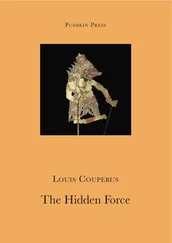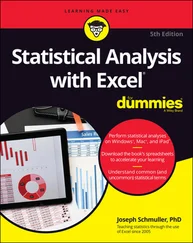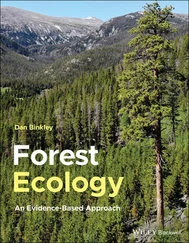Figure 1.12shows the evolution of the probability of state transitions as the distance from the nest changes. We see that, overall, there is a high level of persistence within states at any distance from the nest. Nevertheless, it appears that the closer the bird is to the nest (to the right on the x axis), the less likely it is to transition from activity 2 to activity 3. Note that the interest of the chosen covariate in this specific case is debatable; based on the AIC, a model without this covariate would be preferred.
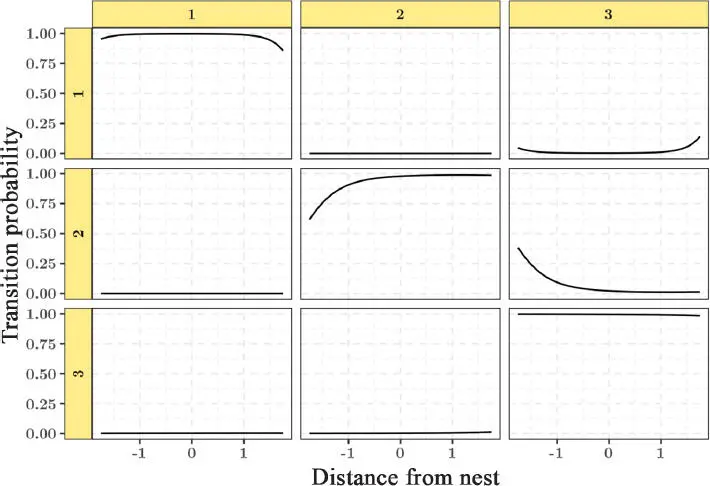
Figure 1.12. Evolution of estimated transition probabilities as a function of distance from the nest. The figure should be read as a transition matrix. The graph in the second line, third column represents the evolution of the probability of a transition from state 2 to state 3 as a function of distance from the nest. As the distance variable has been centered and reduced, the origin represents the mean distance from the nest across all data points. For a color version of this figure, see www.iste.co.uk/peyrard/ecology.zip
1.3.5.4. Choosing a number of states
The calculation of model selection criteria is valuable in helping to chose the number of states to use, as is the AIC. Table 1.1shows AIC and ICL scores for different numbers of activities across our three trajectories.
Table 1.1. Evolution of model selection criteria (AIC and ICL) as a function of the number of hidden states J. In both cases, the best scores are attained for a model with six hidden states
| J |
2 |
3 |
4 |
5 |
6 |
7 |
| AIC |
29,044 |
24,213 |
18,773 |
16,624 |
14,220 |
19,480 |
| ICL |
29,195 |
24,210 |
18,887 |
16,720 |
14,821 |
21,003 |
From a purely statistical perspective, a 6-state model appears preferable here.
Figure 1.13shows states along a trajectory (using the bivariate velocity model) alongside the speed characteristics of these states. We see that a classification into six activities broadly corresponds to the creation of subdivisions in the intermediate state. States previously characterized as belonging to activity 2 or 3 ( Figure 1.9, top left) are divided into four different groups in the new model. In our view, the choice of an optimum number of states in this case should be guided by our capacity to interpret the model, rather than by purely statistical considerations.
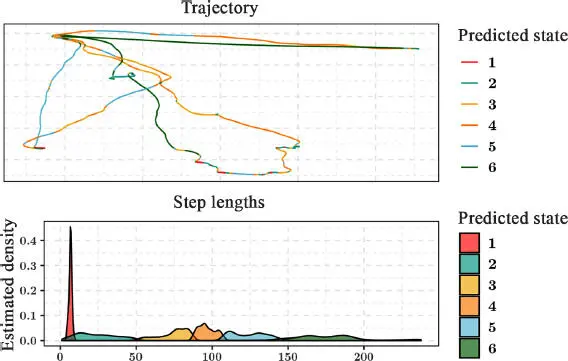
Figure 1.13. Study zone (red dot on the map) and three trajectories of three different red-footed boobies. Measured over a time step of 10 s. For a color version of this figure, see www.iste.co.uk/peyrard/ecology.zip
Akaike, H. (1973). Information theory as an extension of the maximum likelihood principle. In Second International Symposium on Information Theory , Petrov, B.N., Csaki, F. (eds). Akademiai Kiado, Budapest.
Bacci, S., Pandolfi, S., Pennoni, F. (2014). A comparison of some criteria for states selection in the latent Markov model for longitudinal data. Advances in Data Analysis and Classification , 8(2), 125–145.
Biernacki, C., Celeux, G., Govaert, G. (2000). Assessing a mixture model for clustering with the integrated completed likelihood. IEEE Transactions on Pattern Analysis and Machine Intelligence , 22(7), 719–725.
Calenge, C., Dray, S., Royer-Carenzi, M. (2009). The concept of animals’ trajectories from a data analysis perspective. Ecological Informatics , 4(1), 34–41.
Carpenter, B., Gelman, A., Hoffman, M.D., Lee, D., Goodrich, B., Betancourt, M., Brubaker, M., Guo, J., Li, P., Riddell, A. (2017). Stan: A probabilistic programming language. Journal of Statistical Software , 76(1), 1–32.
Dempster, A., Laird, N., Rubin, D. (1977). Maximum likelihood from incomplete data via the EM algorithm. Journal of the Royal Statistical Society , 39(1), 1–38.
Elwen, S., Meÿer, M.A., Best, P.B., Kotze, P., Thornton, M., Swanson, S. (2006). Range and movements of female Heaviside’s dolphins (Cephalorhynchus heavisidii), as determined by satellite-linked telemetry. Journal of Mammalogy , 87(5), 866–877.
Freitas, C., Lydersen, C., Fedak, M.A., Kovacs, K.M. (2008). A simple new algorithm to filter marine mammal Argos locations. Marine Mammal Science , 24(2), 315–325.
Gloaguen, P., Mahévas, S., Rivot, E., Woillez, M., Guitton, J., Vermard, Y., Etienne, M.-P. (2015). An autoregressive model to describe fishing vessel movement and activity. Environmetrics , 26(1), 17–28.
Guédon, Y. (2007). Exploring the state sequence space for hidden Markov and semi-Markov chains. Computational Statistics & Data Analysis , 51(5), 2379–2409.
Gurarie, E., Andrews, R.D., Laidre, K.L. (2009). A novel method for identifying behavioural changes in animal movement data. Ecology Letters , 12(5), 395–408.
Jammalamadaka, S.R. and Sengupta, A. (2001). Topics in Circular Statistics , Volume 5. World Scientific, Singapore.
Johnson, D.S., London, J.M., Lea, M.-A., Durban, J.W. (2008). Continuous-time correlated random walk model for animal telemetry data. Ecology , 89(5), 1208–1215.
Lopez, R., Malardé, J.-P., Danès, P., Gaspar, P. (2015). Improving Argos Doppler location using multiple-model smoothing. Animal Biotelemetry , 3(1), 32.
Lunn, D.J., Thomas, A., Best, N., Spiegelhalter, D. (2000). Winbugs – A Bayesian modelling framework: Concepts, structure, and extensibility. Statistics and Computing , 10(4), 325–337.
Michelot, T., Langrock, R., Patterson, T.A. (2016). moveHMM: An R package for the statistical modelling of animal movement data using hidden Markov models. Methods in Ecology and Evolution , 7(11), 1308–1315 [Online]. Available at: https://besjournals.onlinelibrary.wiley.com/doi/abs/10.1111/2041-210X.12578.
Morales, J.M., Haydon, D.T., Frair, J., Holsinger, K.E., Fryxell, J.M. (2004). Extracting more out of relocation data: Building movement models as mixtures of random walks. Ecology , 85(9), 2436–2445.
Nathan, R., Getz, W.M., Revilla, E., Holyoak, M., Kadmon, R., Saltz, D., Smouse, P.E. (2008). A movement ecology paradigm for unifying organismal movement research. Proceedings of the National Academy of Sciences , 105(49), 19052–19059.
Patterson, T.A., Thomas, L., Wilcox, C., Ovaskainen, O., Matthiopoulos, J. (2008). State–space models of individual animal movement. Trends in Ecology & Evolution , 23(2), 87–94 [Online]. Available at: http://www.sciencedirect.com/science/article/pii/S0169534707003588.
Patterson, T.A., McConnell, B.J., Fedak, M.A., Bravington, M.V., Hindell, M.A. (2010). Using GPS data to evaluate the accuracy of state–space methods for correction of Argos satellite telemetry error. Ecology , 91(1), 273–285.
Rabiner, L.R. (1989). A tutorial on hidden Markov models and selected applications in speech recognition. Proceedings of the IEEE , 77(2), 257–286.
Tusell, F. (2011). Kalman filtering in R. Journal of Statistical Software , 39(2), 1–27.
de Valpine, P., Turek, D., Paciorek, C., Anderson-Bergman, C., Temple Lang, D., Bodik, R. (2017). Programming with models: Writing statistical algorithms for general model structures with NIMBLE. Journal of Computational and Graphical Statistics , 26, 403–413.
Читать дальше



